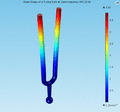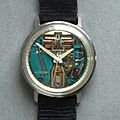Tuning fork facts for kids
A tuning fork is a cool tool that looks like a two-pronged fork. It's usually made from a U-shaped piece of metal, like steel. When you hit it against something, it vibrates and makes a very clear, steady sound. This sound is a specific musical note, called a pitch. The pitch depends on how long the two prongs are.
Tuning forks are mostly used to help tune other musical instruments. They are also used in some tests to check how well people can hear.
Contents
What is a Tuning Fork?
The tuning fork was invented in 1711 by a British musician named John Shore. He was a trumpeter for the royal court and worked with famous composers like George Frideric Handel and Henry Purcell.
The fork shape is special because it makes a very pure tone. This means that most of the sound energy is at the main note you hear. There are very few extra sounds called overtones. This is different from other things that vibrate, like a guitar string, which makes many overtones. Because the tuning fork's sound is so pure, it's much easier to tune other instruments by comparing their sound to the fork's clear note.
Another cool thing about the fork shape is how it vibrates. When the prongs move in and out, the handle also moves up and down a tiny bit. This small movement lets you hold the fork without stopping its vibration. It also helps the handle pass the vibration to a resonator. A resonator is often a hollow box that makes the sound much louder. Without a resonator, like pressing the handle against a table, the sound from a tuning fork is very quiet. This is because the sound waves from each prong cancel each other out a bit.
Tuning forks are usually set to the correct pitch at the factory. But they can be changed! If you file the ends of the prongs, the pitch goes up. If you file the inside of the prongs near the base, the pitch goes down.
The most common tuning fork makes the note A = 440 Hz. This is a standard pitch used by some orchestras to tune their instruments. It's the same note as the second string on a violin, the first string on a viola, and an octave higher than the first string on a cello, when played open. You can find tuning forks for many different musical notes.
How are Tuning Forks Used?
Tuning forks have traditionally been used to tune musical instruments. Today, many people use electronic tuners instead. However, tuning forks can also be made to vibrate continuously using electricity. This is done by placing electromagnets near the prongs and connecting them to an electronic circuit.
In Musical Instruments
Some keyboard musical instruments have parts that work like tuning forks. A famous example is the Rhodes piano. It has hammers that hit special metal parts, which then vibrate like tuning forks to make music.
In Watches
The Accutron was a special type of watch made by Bulova starting in 1960. It used a small steel tuning fork that vibrated 360 times per second (360 hertz). This tuning fork was powered by a battery and helped the watch keep time much more accurately than older watches. If you held an Accutron watch to your ear, you could hear the soft humming sound of the tuning fork.
In Medicine
Doctors often use tuning forks, usually a C-512 one, to check a patient's hearing. They also use lower-pitched ones, like a C-128, to check if a patient can feel vibrations. This helps them check the nervous system.
Tuning forks are also used in some alternative medicine practices, like sonopuncture and polarity therapy.
For Radar Guns
A radar gun, which measures the speed of things like cars or sports balls, is often checked using tuning forks. These forks are labeled with the speed and radar band they are meant to calibrate, not with a musical frequency.
In Gyroscopes
Special types of tuning forks, like doubled or H-shaped ones, are used in advanced devices called Vibrating Structure Gyroscopes. These are used in things like navigation systems.
Images for kids
-
This is a quartz crystal from a modern quartz watch. It's shaped like a tiny tuning fork and vibrates very fast, at 32,768 Hz.
-
This is a 1 kHz tuning fork vacuum tube oscillator from 1927. It was used as a very accurate way to measure frequency.
See also
 In Spanish: Diapasón para niños
In Spanish: Diapasón para niños






